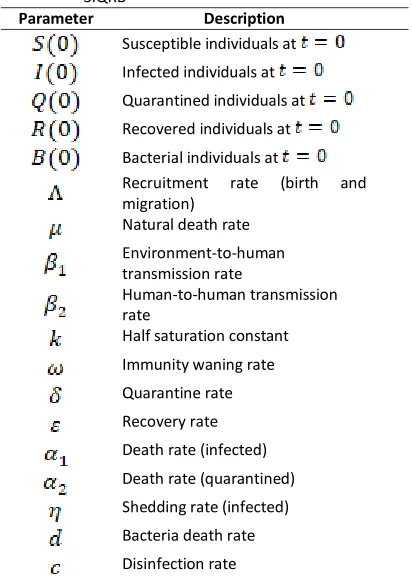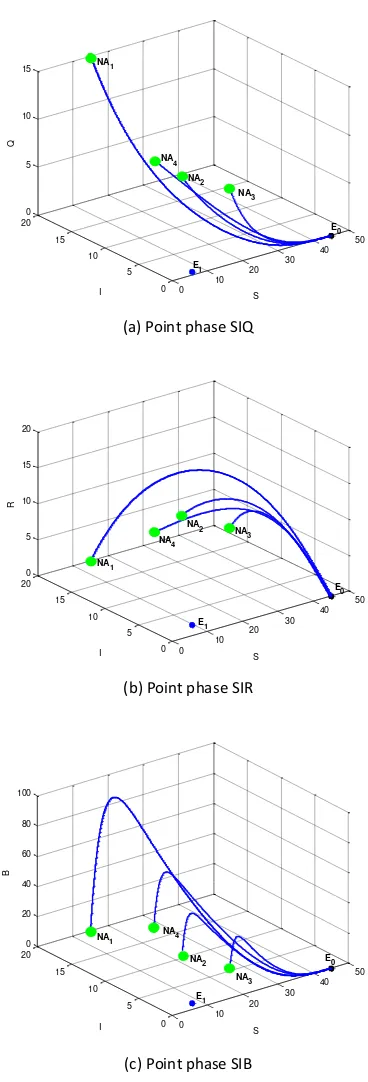15
Model of Cholera Disease Spreadwith Quarantine (Tyas, et al.)
Dynamical Analysis of Model for Cholera Disease Spread with Quarantine
Tyas Husadaningsih
1*, Wuryansari Muharini Kusumawinahyu
2, Moch. Aruman Imron
31Master Program of Mathematics, Faculty of Mathematics and Natural Sciences, University of Brawijaya, Malang,
Indonesia
2Department of Mathematics, Faculty of Mathematics and Natural Sciences, University of Brawijaya, Malang, Indonesia
Abstract
In this paper, the model of cholera disease spread with quarantine is discussed. It is assumed that the spread of cholera not only through direct contact between susceptible human populations with bacteria but also through direct contact between susceptible human populations with infected human populations and reduced bacterial populations not only die naturally but can also be done by means of extermination bacteria. Determination of equilibrium points, existence and local stability of equilibrium points are investigated. Numerical simulations are performed to illustrate the results of the analysis.
Keywords: Dynamical Analysis, Model of Spread Cholera, Runge-Kutta Method 4th order, Local Stability, Quarantine.
INTRODUCTION
Cholera disease is a disease caused by drinking water contaminated by poor sanitation or food contaminated by Vibrio cholera bacteria. Some symptoms of cholera are watery diarrhea, vomiting and leg cramps. Cholera diseases can be
transmitted by direct contact between
susceptible populations and the bacterial populations present in the environment [1]. In addition cholera disease can also be transmitted through direct contact between susceptible populations with infected individuals [2].
Cholera disease has spread globally in 1883. Outbreaks of cholera disease in Indonesia occurred since 1992. In 2008-2009 recorded 98,585 people infected with cholera and 4,287 deaths occurred [3]. Based on WHO (World
Health Organization) data estimated at
3,000,000-5,000,000 people infected with
cholera diseases annually and recorded about 100,000-120,000 cases of cholera suffering death annually [4]. The phenomenon shows that cholera disease poses a global threat to the world, especially in the areas of health, social and economic dynamics.
Based on the history of cholera disease, it is necessary to study the spread of cholera disease. The method used to determine the spread of disease is by using mathematical model of disease epidemic. The epidemic model known since 1927 is often referred to as the SIR type
Correspondence address:
Tyas Husadaningsih
Email : [email protected]
Address : Dept. Mathematics, Faculty of Mathematics and Natural Sciences, University of Brawijaya, Veteran
model proposed by Kermack and McKendrick [5].
The SIR model is divided into three
compartments, namely S (Susceptible) which states the population is susceptible to disease, I (Infected) which states the population is infected with the disease, and R (Recovered) which states the population is cured of the disease. Furthermore, the model used to determine the spread of cholera disease is the SIRB model (Susceptible-Infected- Recovered -Bacterial) [2,6,7,8]. In the SIRB model [2], it modifies from the SIRB model [8] by adding vaccinations and bacterial eradication. The SIRB model was developed into the SIQRB model (Susceptible, Infected, Quarantine, Recovered, Bacteria) by adding class Q (Quarantine) [1].
MATERIALS AND METHODS Model Formulation
In this research, we modified the SIQRB model (Susceptible, Infected, Quarantine, Recovered, Bacteria) [1] by adding direct contact of susceptible human populations to infected human populations and bacterial eradication in the SIRB model [2].
Determination of the Equilibrium Point
A dynamical system is a system whose condition in the future will be known if given conditions in the present or past [9]. In completing the dynamic analysis, the first step is to determine the equilibrium point in the mathematical model. The equilibrium point is obtained from equilibrium equations of the system of equations, that is when the population growth rate of SIQRB is zero or equal to zero [10]. From the completion of the equilibrium point that has been obtained it will get the existence of conditions from the point of equilibrium.
Stability of the Equilibrium Point
In this paper, a local equilibrium stability analysis is performed. The determination of local stability begins with a linearization model to be formed Jacobian matrix. From the Jacobian matrix, the roots of characteristic equations or eigen values in the linear system are determined. The stability point is stable locally if the real part of the characteristic roots is negative or equal to zero.
Numerical Simulation
Numerical simulation is done with MATLAB software by applying Runge-Kutta method 4th
order. The initial steps taken by determining the value of parameters that fit the terms of existence and the stability requirements of the equilibrium point. Furthermore, in the last step is interpreting the results of numerical simulation in the form of phase portrait graph and the solution curve with time.
RESULT AND DISCUSSION Model Formulation
In this model, the modifications [1] are made by adding direct contact of susceptible human populations and infected human populations as well as the eradication of bacteria in the model [2]. In the SIRB model and SIQRB model can be written as follows
SIRB Model Formulation [4]
SIQRB Model Formulation [3]
Modified models of equations (1) and (2) become as follows
Diagram of compartment model epidemic cholera of equation (3) can be seen in Figure 1. Description of model parameter of cholera disease can be seen in Table 1 as follows.
17
Model of Cholera Disease Spreadwith Quarantine (Tyas, et al.)
Figure 1. SIQRB Model Compartment Diagram
Table 1. Parameter values and initial conditions for the SIQRB
Parameter Description
Susceptible individuals at
Infected individuals at
Quarantined individuals at
Recovered individuals at
Bacterial individuals at
Recruitment rate (birth and
migration) Natural death rate
Environment-to-human transmission rate
Human-to-human transmission rate
Half saturation constant
Immunity waning rate
Quarantine rate
Recovery rate
Death rate (infected)
Death rate (quarantined)
Shedding rate (infected)
Bacteria death rate
Disinfection rate
Stability of Equilibrium Points
The equilibrium point of model (3) is obtained when
, that is,
where
So that is obtained the value of endemic equilibrium point as follows.
The local stability analysis of the system
equilibrium point (3) is determined by
where
Theorem 1. The disease free equilibrium point on system (3) is as follow.
Proof. The Jacobian matrix at point is obtained by substituting the equilibrium point in the matrix is obtained.
where
The eigen value of is obtained by solving. The characteristic equation
Then generated three roots equation of negative characteristic is
and while the other eigen value is the eigen values of the matrix
It is seen that the matrix X has a value
and
Based on [9], the equilibrium point is asymptoticallystable when the value
and Stability
require-ments causing existence condition is not fulfilled
Theorem 2. The endemicEquilibrium point on system is as follow.
Proof. The Jacobi matrix at point is obtained by substituting the equilibrium point in matrix
is obtained
where
The eigen value of is obtained by
solving , that is
where
19
Model of Cholera Disease Spreadwith Quarantine (Tyas, et al.)
negative real part if it qualifies several of the following criteria :
1. Requirements for 2. Requirements for 3. Terms for 4. Terms for 5. Terms for
Numerical Method and Simulations
The numerical method of epidemic model of spreading cholera disease of SIQRB is solved using MATLAB R 2010a software with Runge-Kutta method of order 4. The simulation is done in order to illustrated the result of analysis result so that the behavior of system solution (3) can be depicted graphically. There are two simulated cases that are numerical simulations showing the stability of the equilibrium point
and numerical simulations showing the stability
of the equilibrium point
The first parameter is chosen to simulate the first equilibrium point is
The condition is indicated by modifying various initial values
and
as shown in Figure 1 and Figure 2. Figure 2 illus-trates the subpopulation change between by using 4 initial values. It appears that the number of susceptible human populations can survive while the human population is infected, the hu-man population is quarantined, the huhu-man popu-lation recovered. While the bacterial popupopu-lation is extinct. This condition can be said that the bacteria of V. cholera and infected population did not successfully infect the vulnerable population.
Based on the parameter values, the stability condition of the equilibrium point is
and
then the number of each subpopulation will go to equilibrium-free equilibrium point
. Therefore is stable as-ymptotically local.
0
Figure 1. Stability the disease free equilibrium
0 200 400 600 800 1000
Figure 2. The solution curve of endemic equilibrium point to time
Select the parameter value endemic by
changing the parameter value while
first parameter value, then the stability condition of equilibrium point is not fulfilled. While the conditions of existence and stability are qualify that is the local asymptotic stable. The condition is shown by using various initial values
21
Model of Cholera Disease Spreadwith Quarantine (Tyas, et al.)
0 500 1000 1500 2000
0
0 500 1000 1500 2000
0
0 500 1000 1500 2000
0
0 500 1000 1500 2000
0
Figure 4 illustrates the subpopulation change
between by using 4 initial values.
It appears that the human population is susceptible , the human population is infected
the human population is quarantined the human population recovered and the bacterial population can survive. This condition can be said that the bacteria vibrio cholera and infected population have been infected the vulnerable population.
Based on the parameter values, the stability condition of the equilibrium point is
then the number of each subpopulation will go to the equilibrium point of endemic disease
Therefore is the local asymptotic stable.
CONCLUSION
The SIQRB model is a modification of the model [1] by adding direct contact of susceptible
human populations to infected human
population and bacterial eradication in model [2]. SIQRB model obtained 2 equilibrium point value that is equilibrium point of disease and endemic point of disease . Equilibrium points and are asymptotically stable locally on terms already discussed in the previous discussion. The equilibrium point results are
investigated using numerical simulations
according to the analysis.
REFERENCES
[1] Lemos-Paiao, A.P., C.J. Silva., D.F.M. Torres. 2017. An epidemic model for cholera with optimal control treatment. J. Comput. Appl.
Math. 318. 168-180.
[2] Sun, G., J. Xie, S. Huang, Z. Jin, M. Li, L. Liu. 2017. Transmission dynamics of cholera:
Mathematical modeling and control
strategis. J. Commun. Nonlinear. Sci. Numer.
Simulat.Elsevier B. V. 45.b235-244.
cholera outbreaks in Zimbabwe. DOI: 10.1073/pnas.1019712108.
[4] World Health Organization (WHO). 2011. Cholera Fact Sheet. Geneva: World Health Organization. Available at: http://www. who.int/mediacentre/factsheets/fs107/en/i ndex.html.
[5] Shuai, Z., J.H. Tien. 2012. Cholera models
with hyperinfectivity and temporary
immunity. Bull. Math. Biol. 74. 2423-2445. [6] Cheng, Y., J. Wang, X. Yang. 2012. On the
global stability of a generalized cholera epidemiological model. J. Biol. Dynamics.
6(2). 1088-1104.
[7] Khan, M.A., A. Ali, L.C.C. Dennis, T. Gui. 2015. Dynamical behavior of cholera epidemic model with non-linear incidence rate. Appl. Math. Sci. 9(20). 989-1002. [8] Wang, J., C. Modnak. 2011. Modeling
cholera dynamics with controls. Canadian
Appl. Math. Quarterly. 19(3), 255-273.
[9] Panfilov, A. 2004. Qualitative of differential equation. Utrect University. Utrecht. [10] Boyce, W.E., R.C. Diprima 2012. Elementary
differential equation and boundary value problems, 9th Ed., John Willey and Sons, Inc.
United State of America.
[11] Murray, J.D. 2002. Mathematical biology: an introduction, 3rd Ed. Springer-Verlg, Inc.



